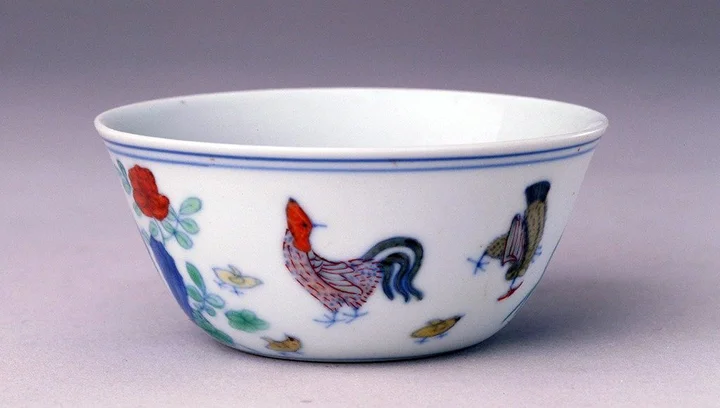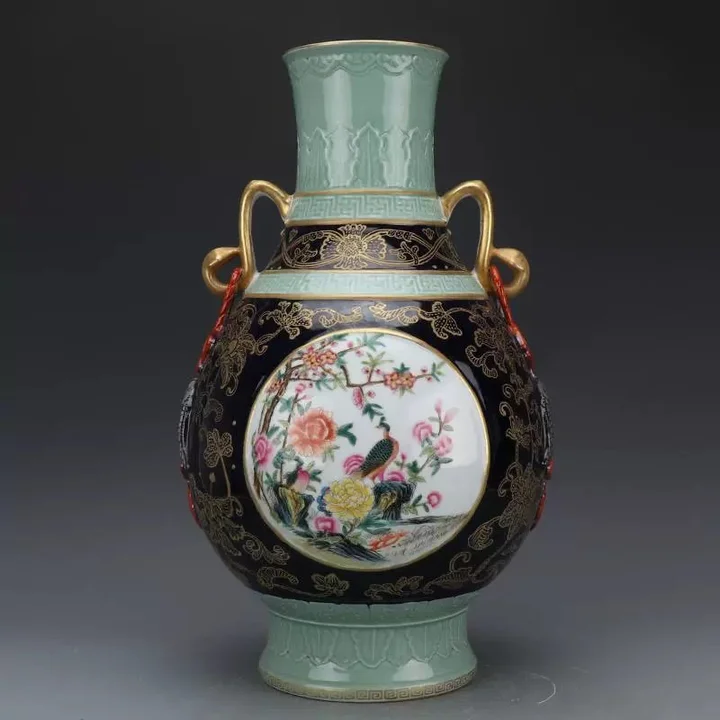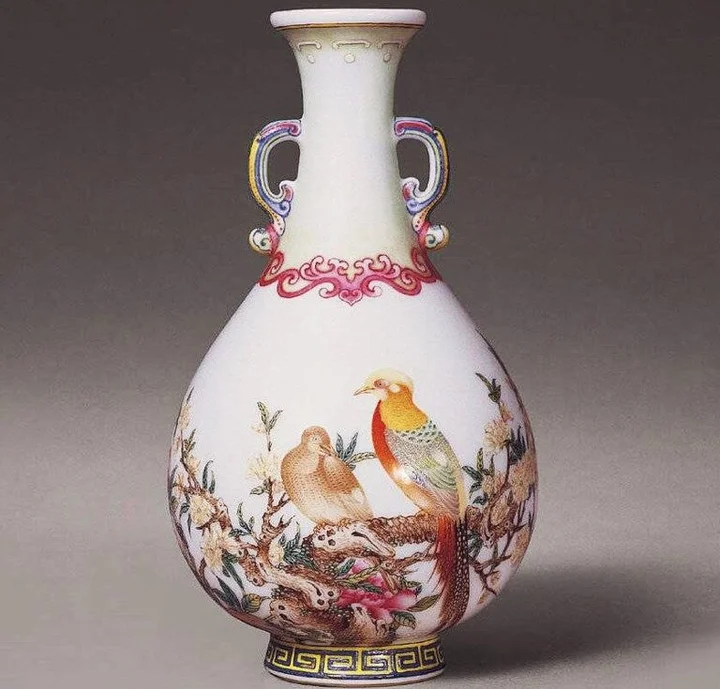Top 10 Most Valuable Chinese Porcelains
Chinese porcelain evolved from pottery, and the original porcelain originated more than 3,000 years ago. By the Song Dynasty, famous porcelain and famous kilns had spread throughout most of China, and it was the most prosperous period of the porcelain industry.

1. The blue-and-white plum vase
The blue-and-white plum vase of the Yuan Dynasty, Xiao He chases Han Xin under the moon, was unearthed at the Muying Tomb in Jiangning District, Nanjing City, and was collected in the Nanjing Municipal Museum. It is the "treasure of the town hall" of the Nanjing Museum, one of the three masterpieces of Chinese porcelain, and it is also prohibited by the State Administration of Cultural Heritage to go abroad (border) to exhibit cultural relics. This bottle is a Jingdezhen kiln product. The height is 44.1, the diameter is 5.5, the abdominal diameter is 28.4, and the bottom diameter is 13cm. The quality of the embryo is white and fine, the blue and white color is stable, the white glaze is pure, and the transparency is extremely high. No lid, small mouth, flat and thick rim, short and slender neck, flat shoulders, converging below the shoulders, slender shin, slanted near the bottom, flat bottom. The shape is dignified and graceful, and the historical story of "Xiao He Chasing Han Xin under the Moon" is drawn on the abdomen. The images of Xiao He, Han Xin and Duke Shou are drawn with full personality, and the background is pine, bamboo, plum, banana and rock. There are five groups of decorative belts outside the picture. The entire plum vase is decorated with elaborate decorations, and the decorative belts are arranged in a dense and dense layout. It is the essence of blue and white porcelain in the late Yuan and early Ming Dynasty.

2. Qing Qianlong Pastel Hollow Auspicious Yuyu Turning Heart Vase
The heart-turning bottle is a treasure of Chinese ceramic art. It belongs to a bottle type created in the Qing Dynasty. In a perforated bottle, a rotatable inner bottle is set, and various patterns are painted on it. The bottle body of the "turning heart bottle" is composed of an inner bottle, an outer bottle and a base which are fired separately. The upper part of the inner bottle is an exposed bottle mouth, and the bottle body is cylindrical, with decorative paintings on it, including four seasons scenery, landscape characters, flowers, birds, insects and fish. When moving the inner bottle, through the holes in the outer bottle, you can see different pictures, like a revolving lantern. This is an official kiln vase in the Qianlong era. It has a uniform body. The body of the bottle is printed with a carp pattern and the mouth of the bottle has auspicious characters. It is a symbol of auspiciousness and wealth. The auction price is as high as 254.1 million yuan, which shows that it is extremely precious.

3. Plain three-color duck aromatherapy
The cute shape of the plain three-color duck-shaped aromatherapy in the Chenghua period of the Ming Dynasty, also known as incense burner and incense cage, is a kind of living utensil for incense. In the early days of ancient China, incense sticks were all made of ceramics, either with a constricted mouth or a flat round belly, or in a spherical shape, or with a beam, or with two ears, or with feet. Multiple round holes are used to distribute fragrance.

4. Chenghua Doucai Chicken Cup
The Chenghua Doucai Chicken Cup is an artistic treasure in the traditional ceramics of the Han nationality, and it belongs to the imperial wine cup of the Chenghua Emperor in the Ming Dynasty. It is on the outer wall of the skimming bowl with a diameter of about eight centimeters. After the outline of the decoration is lightly traced with thin blue and white lines, it is glazed into the kiln and fired at a high temperature of about 1300 degrees to form the carcass. Fill the reserved blue and white decoration with equal color and then enter the kiln for low-temperature roasting for the second time. The outer wall is divided into two groups by peony lake stone and bluegrass lake stone. A group of painted roosters held their heads high, a hen and a chick were pecking at a centipede, and two other chicks were playing. Another group depicts a rooster crowing by its neck, a hen and three chicks pecking at a centipede, The pictures are vivid and full of interest, and there are many imitations in later generations.

5. The "Longevity Continuing" Daji Gourd Vase
The "Longevity Continuing" Daji Gourd Vase in Qianlong of the Qing Dynasty is an imperial foreign-colored porcelain. This is a national treasure-level cultural relic hidden in the deep palace at that time. The whole looks like a gourd, which means that the emperor has infinite longevity. According to reports, it is the first Qianlong pastel porcelain worth 200 million in my country. As a traditional mascot and artwork of the Chinese nation, the gourd bottle reached its peak during the Qianlong period of the Qing Dynasty, and the auction price was also the highest. Its ingenious painting skills, luxurious and elaborate decoration skills, and breathtaking firing process are rare in the world.

6. Northern Song Dynasty Ru kiln celadon glaze sunflower brush wash
Ru kiln is the pinnacle of Chinese porcelain. Almost all of the 79 pieces of Ru kiln left in the world are collected by the world's major museums. In April 2012, at the "Chinese Porcelain and Crafts" auction held at Sotheby's Hong Kong, the 900-year-old "Ru Kiln Celadon Glazed Sunflower Wash in the Northern Song Dynasty" was sold at a sky-high price of HK$207.86 million, setting a new world auction record for Song Dynasty porcelain. The main reason why Ru kiln is precious is that it was an official kiln only used by the court in the Northern Song Dynasty, and it was only fired for about 20 years. It is glazed with precious agate, and its color is as beautiful as "the place where the rain passes and the sky clears and the clouds break". Since the Song, Yuan, Ming and Qing dynasties, Ru porcelain has been hidden in the palace and regarded as a treasure. Therefore, there is a saying among the people that "even if you have a wealth of wealth, it is not as good as a piece of Ru porcelain".

7. Qing Dynasty Qianlong Imperial Enamel Bowl
Qing Dynasty Qianlong Imperial Enamel Bowl with Apricot Forest and Spring Swallows: The bowl is painted with apricot flowers in full bloom, green willows blowing in the spring breeze, and two swallows flying in the wings. On the side, there is a poem inscribed in regular script written by Qianlong's imperial pen: "Jade scissors pass through flowers, neon clothes bring the moon back", and the bottom of the bowl has a blue script mark "Qianlong Year". The bowl is beautiful in shape, warm in white glaze and exquisite in craftsmanship. It is a masterpiece of Qianlong enamel porcelain. This is a work in disguised form in the imperial enamel ware made by Emperor Qianlong of the Qing Dynasty, which was sold for 123 million yuan at the auction.

8. Ji blue glaze pastel blooming flowers and birds dark engraved turquoise green Ruyi double-eared big bottle
This is a very valuable official kiln treasure during the Qianlong period. There are more than a dozen pieces in the world, and it was sold at a sky-high price at auction, from the initial $800 to $16 million, creating a miracle of Chinese art in the Western market. Various glazed vase, Qianlong Qing Dynasty, height 86.4cm, diameter 27.4cm, foot diameter 33cm. The bottle mouth is smooth, the neck is long, the belly is long and round, and the feet are circled outward. There are two ears on each side of the neck. There are as many as 15 layers of glazes and colors on the body of the vessel.

9. Qing Dynasty Qianlong enamel color ancient moon Xuan golden pheasant amphora
This is a porcelain commonly known as Gu Yuexuan. It is a representative work of the Qianlong period of the Qing Dynasty. It is small and beautiful in shape, with "double ears" on both sides, uniform layout and bright colors. It was sold at the auction for 115 million Hong Kong dollars. Enamel porcelain was created and fired during the Kangxi period. Most of them were small utensils such as cups, bowls, bottles, and plates, which were specially used for court ornaments and religious sacrificial utensils. This piece is a representative work of the Qianlong period. It is small and beautiful in shape. The neck is decorated with curly grass-shaped ears, and the ruyi pattern on the drooping shoulders is elegant and graceful. The theme pattern on the bottle body is "Huashi Golden Pheasant", which means icing on the cake. The golden pheasant perches on the trunk, with pink flowers and exquisite travertine on the side. The layout of the whole picture is well-proportioned, elegant and delicate, and the colors are stacked on each other, which is rich and colorful.

10. Qing Dynasty Qianlong blue and white seawater red dragon pattern eight auspicious gourd bottle
It was made during the reign of Emperor Qianlong of the Qing Dynasty. The body of the bottle is printed with a red dragon, which is majestic. The bottom of the bottle is also engraved with the words of the reign of Emperor Qianlong of the Qing Dynasty. It was sold at an auction in Beijing for 83.44 million yuan. Since the Tang Dynasty, the gourd bottle is also known as "Daji bottle" because of its homophonic "Fu Lu" and the shape of the vessel, which means great auspiciousness.





